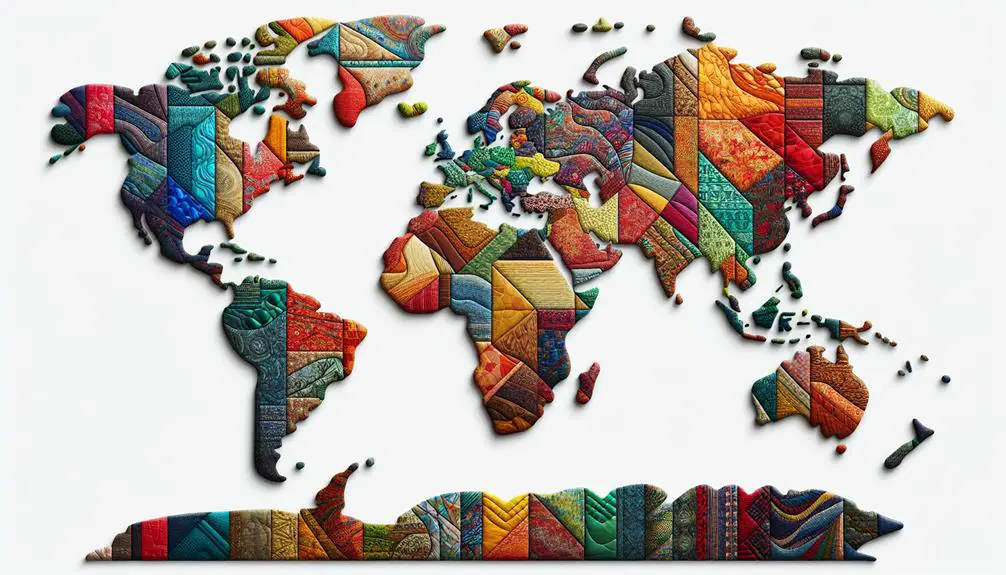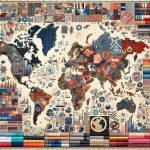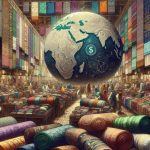You've likely noticed the fabric industry's increasing focus on sustainability and innovation. As organic cotton, Tencel, and recycled polyester gain popularity, the shift towards circular economy practices is undeniable. While fast fashion continues to pose challenges, technological advances in digital textiles and automation are helping cut costs and reduce waste. Asian markets, particularly China, India, and Vietnam, are not only expanding but also driving quality improvements. Additionally, changing consumer preferences are leaning towards ethically produced and culturally significant textiles. So, what's driving these changes, and how are they reshaping the global fabric landscape?
Table of Contents
Key Takeaways
- Sustainable fabrics like organic cotton and recycled polyester are driving the global fabric market towards eco-friendly options.
- Fast fashion's rapid production cycles and low-cost appeal continue to pose challenges to sustainable advancements in the fabric industry.
- Technological innovations, including automation and digital textiles, are enhancing productivity and reducing waste in fabric production.
- Asian markets, led by China, India, and Vietnam, are dominating global textile production with a focus on efficiency and scalability.
- Consumers are increasingly demanding ethically produced and transparent sourcing processes, shifting preferences towards sustainable and culturally significant textiles.
Rise of Sustainable Fabrics
In recent years, you've likely noticed a significant shift towards sustainable fabrics in the fashion industry. This transformation is driven by an increasing awareness of environmental impacts and a consumer demand for eco-friendly materials.
As someone seeking mastery in this field, you understand that sustainable fabrics like organic cotton, Tencel, and recycled polyester are at the forefront of this movement. These materials not only reduce the carbon footprint but also contribute to a healthier planet.
Adopting eco-friendly materials is just one piece of the puzzle. The concept of a circular economy plays an essential role in the rise of sustainable fabrics. In a circular economy, products are designed to be reused, repaired, and recycled, minimizing waste.
You've probably seen brands implementing take-back programs and offering garments made from recycled fibers. This approach not only conserves resources but also fosters innovation in fabric technology.
Impact of Fast Fashion
While sustainable textiles gain traction, the widespread influence of fast fashion continues to challenge these eco-friendly advancements. Fast fashion's rapid production cycles and low-cost allure often overshadow the benefits of sustainable alternatives. The demand for the latest trends at minimal prices drives companies to cut corners, resulting in questionable ethical production and significant environmental impact.
Fast fashion's supply chain is notoriously opaque, making it challenging to guarantee transparency in labor practices. Many workers in these supply chains endure poor working conditions and receive meager wages, which contradicts the principles of fair labor practices. Companies prioritize speed and cost-efficiency over the well-being of their workforce, leading to a cycle of exploitation.
Moreover, the environmental impact of fast fashion is staggering. The industry is one of the largest polluters, with textile waste and water contamination being significant issues. Synthetic fabrics, commonly used in fast fashion, contribute to microplastic pollution, further exacerbating environmental degradation.
While you might appreciate the affordability and accessibility of fast fashion, it's essential to take into account the hidden costs borne by both people and the planet. Embracing more ethical production methods and sustainable choices can make a significant difference.
Technological Innovations
Technological innovations are revolutionizing the fabric industry by making sustainable practices more feasible and efficient. You'll find that the integration of digital textiles and automation is transforming production processes, cutting costs, and reducing waste. This shift not only enhances productivity but also allows for more complex designs and customizations.
Here are four key areas where technology is making a significant impact:
- Digital Textiles: Advanced digital printing techniques enable precise patterns and colors without excess dye, reducing environmental harm.
- Automation: Automated machinery enhances efficiency, minimizes human error, and accelerates production timelines.
- Smart Fabrics: Fabrics embedded with sensors and electronics adapt to environmental conditions, offering functionalities like temperature regulation and health monitoring.
- Nanotechnology: By incorporating nanoparticles, fabrics gain properties such as water resistance, strength, and antibacterial features.
Mastering these innovations allows you to stay ahead in a competitive market. Digital textiles and automation streamline workflows, while smart fabrics and nanotechnology open new avenues for product development. As you embrace these advancements, you'll not only improve sustainability but also deliver cutting-edge products that meet modern demands.
Growth in Asian Markets
As Asian markets expand rapidly, they're becoming pivotal players in the global fabric industry. You're witnessing a surge in textile production, driven by technological advancements and cost-effective labor. Countries like China, India, and Vietnam are leading the charge, contributing significantly to market competition.
To give you a clearer picture, here's a snapshot of key metrics:
| Country | Textile Production (in billion USD) | Market Share (%) |
|---|---|---|
| China | 276 | 34 |
| India | 150 | 18 |
| Vietnam | 50 | 6 |
Asian markets aren't just producing more; they're innovating and improving quality. This proliferation creates a highly competitive environment, pushing global players to adapt or risk falling behind. The region's strategic emphasis on efficiency and scalability ensures that it remains a formidable force in the fabric industry.
You're likely seeing the effects of this competition in both pricing and availability of high-quality textiles. Asian markets' relentless drive for excellence and cost efficiency means that they will continue to dominate, shaping the future of textile production globally. As you navigate these changes, understanding the dynamics at play in these markets will be essential for maintaining a competitive edge.
Shifts in Consumer Preferences
Consumer preferences are shifting towards sustainable and ethically produced fabrics, influencing global market trends. You've likely noticed that today's consumers are more informed and conscientious about their purchases. This change is driving significant transformations in the fabric industry.
- Eco-friendly Choices:
People are increasingly opting for materials that have a lower environmental impact. Organic cotton, bamboo, and recycled fibers are in high demand.
- Ethical Sourcing:
There's growing scrutiny over the origins of fabrics. Consumers want assurances that workers are treated fairly and that production processes are transparent.
- Cultural Influences:
The desire for unique, culturally significant textiles is on the rise. Indigenous patterns and traditional weaves are making a comeback, reflecting a broader appreciation for cultural heritage.
- Luxury Demand:
High-end consumers aren't just looking for quality but also for sustainable luxury. Fabrics that combine opulence with eco-consciousness are becoming increasingly popular.
Frequently Asked Questions
How Are Global Trade Policies Affecting Fabric Prices?
Oh, you thought fabric prices were stable? Think again! Global trade policies' tariff impacts and market volatility are making prices dance like marionettes. You'll need a crystal ball to forecast those ever-changing costs accurately.
What Are the Main Challenges Facing the Traditional Textile Industry Today?
You're facing major challenges in the traditional textile industry, primarily due to automation technology replacing manual labor and the urgent need to adopt sustainability practices. Mastering these areas will determine your success in this evolving market.
How Do Geopolitical Tensions Influence Fabric Supply Chains?
Geopolitical tensions disrupt supply chains, challenging fabric economics. While global trade policies aim for stability, political conflicts create uncertainty. You'll find that managing these complexities demands strategic planning to guarantee your fabric supply remains consistent and cost-effective.
What Role Do Labor Costs Play in Fabric Production Economics?
Labor costs have a substantial impact on fabric production economics. You'll find that high labor costs often drive the need for increased production efficiency. By optimizing efficiency, you can offset expenses and maintain competitive pricing in the market.
How Is Climate Change Impacting Fabric Raw Material Availability?
Think of a world where forests vanish like Atlantis. Climate change's impact on deforestation disrupts raw material availability. You're seeing shifts towards sustainable alternatives, echoing our need for resourceful solutions in fabric production.
- How Does Ring Spun Cotton Affect Garment Fit and Shape Retention? - August 13, 2024
- What Are the Challenges in Producing Ring Spun Cotton? - August 13, 2024
- Is Ring Spun Cotton Suitable for Plus-Size Clothing? - August 13, 2024




